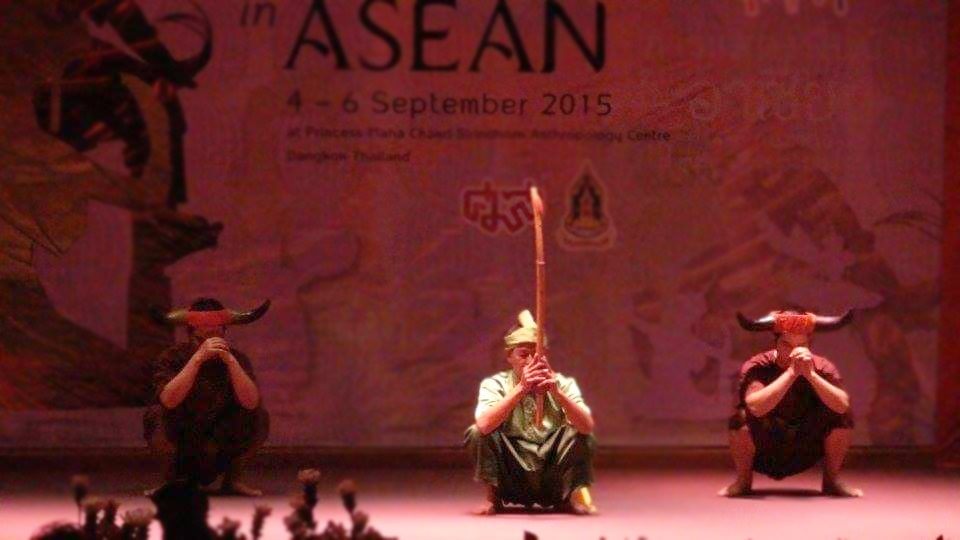នៅក្នុងតំបន់ខាងត្បូងទន្លេសាប មានរបាំមួដែលគេហៅថា របាំរាំស្នែងទន្សោង របាំស្នែងទន្សោង ឬរបាំទន្សោង។ គេឃើញរបាំនេះមាននៅក្នុងខេត្តមួយចំនួនដូចជា ខេត្តកំពង់ឆ្នាំង ខេត្តកំពង់ស្ពឺ និងខេត្តពោធិសាត់។ នៅឯទីក្រុងភ្នំពេញ សាលាមធ្យមវិចិត្រសិល្បៈ សាកលវិទ្យាល័យភូមិន្ទវិចិត្រសិល្បៈ និងនាយកដ្ឋានទស្សនីយភាព ក៏មានសម្តែងរបាំទន្សោងនេះដែរ។
គេហៅរបាំនេះថា របាំទន្សោង ដោយសារខ្លឹមសារសំខាន់របស់របាំ ពាក់ព័ន្ធនឹងសត្វ ទន្សោង មានសម្លៀកបំពាក់ ស្នែងទន្សោង និងចលនាកាយវិការរាំត្រាប់តាមសត្វទន្សោង។ នៅភូមិអញ្ចាញរូង ស្រុកបរិបូណ៌ ខេត្តកំពង់ឆ្នាំង មានរឿងព្រេងមួយនិទានថា៖ ថ្ងៃមួយ ព្រះរាជាទ្រង់ត្រាស់បញ្ជាឱ្យព្រានម្នាក់ឈ្មោះ «ព័រ» ចេញទៅបរបាញ់សត្វ។ ក្រោយពីស្វែងរកសត្វព្រៃពេញមួយយប់តែពុំបានជោគជ័យ ព្រាននោះក៏បានមកដល់វាលមួយ ហើយបានឃើញទិដ្ឋភាពដ៏ចម្លែកមួយ គឺសត្វទន្សោងញីឈ្មោលមួយគូកំពុងចែរចង់និងរេរាំជាមួយគ្នា ព្រមទាំងមានសត្វកន្លង់ហើរក្រឡឹងជុំវិញសត្វទន្សោងនោះប្រកបដោយសូរសំឡេងដ៏ពីរោះផង។ ព្រានព័រ ក៏មានអារម្មណ៍សណ្ឋិតស្លុងនៅក្នុងរឿងនេះ ហើយក៏ពុំបានបាញ់សត្វទន្សោងនោះដែរ។ ជាមួយគ្នានោះ ក៏មានសត្វខ្លាមួយដែលប្រុងនឹងចាប់សត្វទន្សោង តែមិនបានចាប់ទៅវិញ ដោយបែរជាគោះជើងតាមចង្វាក់នៃការរេរាំរបស់សត្វទន្សោង។ ឃើញដូច្នោះហើយ ព្រានក៏ប្រញាប់ត្រឡប់ទៅទូលព្រះរាជាអំពីរឿងដ៏ចម្លែកនេះ។
របាំទន្សោង ត្រូវបានគេបង្កើតឡើងទៅតាមរឿងនិទានខាងលើនេះ។ ម្យ៉ាងវិញទៀត គេជឿថា ព្រានឈ្មោះ «ព័រ» នោះក៏មានទំនាក់ទំនងជាមួយនឹងជនជាតិដើមភាគតិច «ព័រ» ដែលរស់នៅក្នុងតំបន់ជួរភ្នំក្រវាញនៃខេត្តកំពង់ឆ្នាំង កំពង់ស្ពឺ និងពោធិសាត់ដែរ។ នៅក្នុងការសម្តែងរបាំទន្សោង គេរៀបដាក់នៅលើឆាក អ្នករាំពីរនាក់ស្លៀកពាក់ជាសត្វទន្សោងញីឈ្មោលមានទាំងពាក់ស្នែងទន្សោងផង ប្រកបដោយចលនានិងកាយវិការរេរាំប្រឡែងលេងនិងចែរចង់គ្នា។ អ្នករាំម្នាក់ស្លៀកពាក់ជាសត្វកន្លង់ ផ្លុំព្លយជានិមិត្តរូប រាំលេងនិងក្រឡឹងជុំវិញសត្វទន្សោង។ អ្នកវាយស្គរម្នាក់ អង្គុយនៅលើឆាកម្ខាងខាងក្រោយ ស្លៀកពាក់ជាសត្វខ្លា និងអ្នកច្រៀងម្នាក់ អង្គុយនៅលើឆាកខាងក្រោយម្ខាងទៀត ស្លៀកពាក់ជាព្រានព្រៃ ដោយមានស្ពាយស្នានៅខ្នង។ ពីក្នុងឆាកក្រោយវាំងនន មានអ្នកផ្លុំឧបករណ៍ព្លយមែនទែនជាសូរដើម្បីកំដររបាំ។ ឯឈុតឆាកនិងសកម្មភាពនៃរបាំទន្សោង គឺមាននៅក្នុងអត្ថន័យខ្លឹមសារដែលអ្នកច្រៀងបកស្រាយ។
——————————————
Wild-Ox Dance
To the south of the Great Lake Tonle Sap, there remains a folk dance called Robaim Roam Snaeng Tunsaong, literally meaning “Dance the Wild-ox Horn Dance” or Robaim Snaeng Tunsaong, meaning “Wild-ox Horn Dance,” or another yet, Robaim Tunsaong meaning “Wild-ox Dance.” Today, the dance can be found in the provinces of Kampong Chhnang, Kampong Spoeu, and Pursat as well as among dance troupes in Phnom Penh, namely, the Secondary School of Fine Arts, the Royal University of Fine Arts, and the Department of Performing Arts.
The Wild-ox Dance owes its name to the use of wild-ox horns and movements. The dance is believed to have its origin in the folktale retold by people in the Anchanh Roung village of the Baribo district in the Kampong Chhnaing province. The Wild-ox Dance concerns a hunter named Poar, who was sent by his king in search of games. The theme enacted includes the account that was retold by the hunter of what happened and why he returned empty-handed upon the king’s request as follow.
After a fruitless search lasting throughout the night, the hunter came to a clearing where the following strange sight met his astonished gaze. A pair of wild oxen were engaged in a tender courtship, dancing while beautifully encircled by bumble bees that made melodious sounds. The hunter was so enraptured and hypnotized by the scene that he refrained himself from shooting at the oxen. Even the tiger that attempted to kill the oxen could not do it, but instead tapped its feet in rhythm accompanying the oxen. The hunter then decided to hasten home to report on the strange affair to the king.
The Wild-ox Dance is based and created on such an incident. It is also believed that the hunter’s name Poar must have had a connection with the Poar indigenous ethnic group, inhabiting along with the Cardamom Mountain ranges in the provinces of Kampong Chhnang, Kampong Spoeu, and Pursat.
The present dance, appearing on stage, includes two dancers dressed as wild oxen with horns playing with one another encircled by another dancer dressed as a bumblebee playing a make-believe mouth organ. There is one drummer dressed as a tiger sitting on the backside of the stage, and one singer dressed as a hunter with a cross-bow on his back sitting on the opposite backside of the stage, while a ploy or mouth organ, producing real sounds, is played offstage.
អត្ថបទដើម៖ បណ្ឌិត សំ សំអាង







